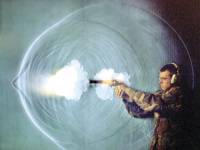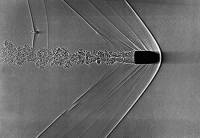MA8103 Non-Linear Hyperbolic Conservation Laws
General information
Background: In the course we study a class of nonlinear partial differential equation called hyperbolic conservation laws. These equations are fundamental in our understanding of continuum mechanical systems, and can be used to describe mass, momentum and enery conservation in mechanical systems. Examples of the use of conservation laws you may have seen in TMA4305 Partial differential equations and TMA4195 Mathematical modeling as well as in courses in physics and fluid mechanics. The equations share many properties that make numerical computations difficult. The equations may, for instance, develop singularities in finite time from smooth initial data. These equations have been extensively studied due to their importance in applications. Examples of applications include weather forecasting, flow of oil in a petroleum reservoir, waves breaking at a shore, and in gas dynamics.
Lecturer: Helge Holden Email: holden [at] math [dot] ntnu [dot] no
Textbook: H. Holden and N. H. Risebro: Front Tracking for Hyperbolic Conservation Laws, Springer, Second edition 2015. The book exists as an eBook, and NTNU students can read and download it freely. There will be an inexpensive paperback edition called "MyCopy" that sells for EUR 24.95 (incl. shipping).
Time and place
For regular weeks the lectures are
Wednesday at 14:15-16 in room 656, Sentralbygg 2 Thursday at 10:15-12 in room 922, Sentralbygg 2
The lectures will be in English, and there will be an oral exam at the end of the semester.
Lecture plan
- Tue, Jan. 12 at 8:15-10:00 (room 922): p. 1-6.
- Wed, Jan. 20: p. 6-9, 53-56. Exercises 1.8 and 1.9 (p. 48-49) are strongly recommended.
- Thu, Jan. 21: p. 56-60.
- Wed, Jan. 27: p. 60-65.
- Thu, Jan. 28: p. 65-73.
- Wed, Feb. 3: p. 73-78.
- Thu, Feb. 4: p. 78-84.
- Wed, Feb. 10: p. 84-88.
- Thu, Feb. 11: p. 95-105.
- Wed, Feb. 17: p. 105-110.
- Fri, Feb. 19 at 8:15-10:00 (room 656, Simastuen): p. 110-115 (the proof of Thm. 3.10 not presented).
- Wed, Feb. 24: p. 115-119.
- Thu, Feb. 25: p. 119-126.
- Wed, Mar. 2: p. 171-175.
- Fri, Mar. 4 at 8:15-10:00 (rom 656, Simastuen): p. 175-180.
- Wed, Mar. 9: NO lecture
- Thu, Mar. 10: p. 180-185.
- Fri, Mar. 11 at 8:15-10:00 (rom 656, Simastuen): p. 185-189.
- Wed, Mar. 16: p. 223-231 (the derivation of the shallow water equations from the Navier-Stokes equations not presented).
- Fri, Mar. 18 at 8:15-10:00 (rom 656, Simastuen): p. 232-235.
- Wed, Mar. 30: NO lecture.
- Thu, Mar. 31: NO lecture.
- Wed, Apr. 6: NO lecture.
- Thu, Apr. 7 (rom 734): p. 235-244.
- Wed, Apr. 13: p. 244-249.
- Fri, Apr. 15 at 8:15-10:00 (rom 656, Simastuen): p. 249-253.
- Wed, Apr. 20: p. 254-260.
- Fri, Apr. 22 at 8:15-10:00 (rom 656, Simastuen): Exercises 2.17-2.19, 5.8
- Fri, Apr. 29 at 13:15-16:00 (rom 656, Simastuen): A brief introduction to Ch. 6. Then Sects. 4.4 and 4.5.
Exam: The exam is oral. At the day of the exam you meet at 9:00 am in my office. The time for each candidate will be decided then.
Curriculum: Ch. 1, p. 1-16; Ch. 2; Ch. 3, p. 91-126; Ch. 4, p. 171-188, 205-216; Ch. 5, p. 223-259; Ch. 6, just the general construction of the front tracking approximation.
Regulations concerning the exam: For the first 20 min the candidate presents a lecture using blackboard only on one of the topics given below. Notes are allowed. It should be a lecture presenting the main parts of the topic, or if the topic is big, a selected part of it. Proofs are encouraged. After that, and for approximately 25 min the candidate will be asked questions about all of the curriculum. Here there will of course be no notes. The topic is decided at the beginning of the exam.
Topics: (A): Ch 2; (B): Ch 3; (C): Ch 4; (D): Ch. 5.


